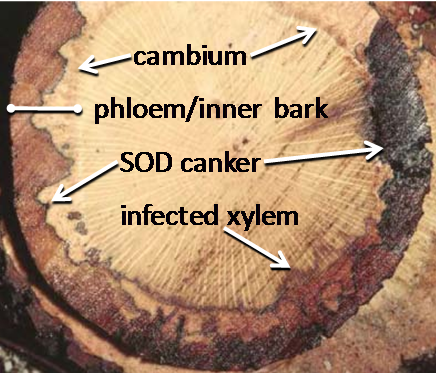
In SOD-susceptible oaks and tanoak, P. ramorum can infect and kill phloem tissue located in the bark of the lower trunk (fig. 1-8). Infections can reach and kill the vascular cambium, the cell layer that produces both phloem and wood (xylem) tissues. The pathogen can also invade the outer xylem (Parke and others 2007, Rizzo and others 2002). Xylem infection appears as dark discoloration that may extend several centimeters into the wood. The pathogen can spread vertically in the xylem and sometimes grows outward from the xylem to form a new canker further up the stem.

Figure 1-8—Cross section through the trunk of a coast live oak showing the extent of Phytophthora ramorum-infected phloem and xylem tissues.
In areas where the cambium has been killed by P. ramorum, no new xylem and phloem can develop. However, if the pathogen becomes inactive (see 1.4.1.4. Changes in canker appearance over time), healthy callus tissue can develop from uninfected live cambium at the edge of the canker. This callus tissue can form new xylem and phloem tissues that may grow over and at least partially close a non-expanding canker.
Cankers normally occur on the lower trunk but occasionally occur on low scaffold branches. In tanoak, cankers sometimes develop many meters up on the main stems. Cankers do not extend more than a few centimeters below the soil line, but can develop on exposed buttress roots.